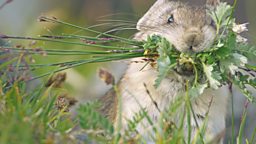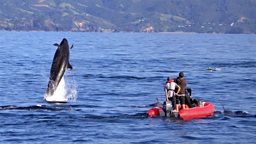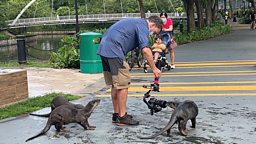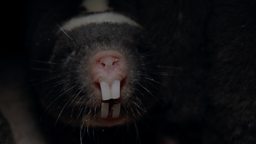Filming one of the most unusual mammals in the world
By Tom Parry, Researcher for Mammals

The Mammals Dark team travelled to Argentina to film one of the least mammal-like mammals in the world – the ‘large hairy armadillo’.

‘Armadillo’ is a Spanish word meaning “little armoured one”. Like all armadillo species, the large hairy armadillo has an armoured shell of tough, overlapping scales or ‘scutes’, a useful anti-predator device. On first impression this particular species might seem quite badly named, but in fact they are very hairy by armadillo standards – they have belly covered in dense fur and long, coarse hairs protruding from between their scales.
Our filming site was an active cattle farm near Buenos Aires and we were there to film a peculiar mating spectacle. The large hairy armadillo’s breeding season lasts only a few short weeks in the late Spring and it presents a rare opportunity to see these usually solitary creatures interact…with hilarious consequences!
As with every shoot in the Dark episode, the biggest problem we faced was lack of light. Thanks to radical improvements in low-light camera technology in recent years, we could film the armadillos under just moonlight as they foraged amongst the grassy fields, using their sharp claws to dig for grubs and insects in the dirt.
However, the centre stage for our mating scene was an abandoned, old milk parlour, which had been left to crumble and decay for more than 60 years – and inside it was far too dark to film in such a way. Lighting the structure conventionally was not an option because it risked disturbing the animals and disrupting their mating behaviour. So we turned to an alternative – infrared light. While it is possible to modify cameras to detect infrared light, almost no mammals can see in the infrared spectrum, making it the perfect way to light a scene without detection.

“I actually quite like filming in the dark because you get to be in complete control of how it looks” explains wildlife cameraman Jo Charlesworth. “I like lighting, you’re in charge of your own destiny a bit more”. However, given Jo and I are also mammals, we had to rig the building with a light we couldn’t see either… which presented its challenges!

Furthermore, the building was too small for a film crew to work in person. The only solution was to rig the building with motorised cameras and lenses which could then be remotely controlled at a distance A bit like an armadillo Love Island. Jo is an expert at building bespoke camera rigs and he devised a system that would allow us to monitor our scene from a farmhouse 1km away. Between it and the parlour building we laid enough cables to power and control a small studio’s worth of cameras and infrared lights.
“The challenge of building a remote rig of that complexity – with five remote cameras working simultaneously - was that there were five-times as many things to go wrong’, explains Jo. ‘Trying to make it all work from a kilometre away was particularly difficult. We had to build quite a lot of bespoke equipment. But it was rewarding in the end because we could have a very low impact on the armadillos.’
Meanwhile, wildlife cameraman Max Smith would work outside with a specialist, low-light camera, alongside Zoologist and armadillo expert Esteban Soibelzon.
So the stage was set. Max and Esteban scanned the surrounding fields with thermal scopes, while Jo and I took up position in the farmhouse 1km away. Sitting down in front of a dazzling array of monitors, switches, control boards and cables, we felt like security guards beginning a long night shift of checking the CCTV.

The bespoke spy rig was an immediate success – within hours our star armadillo popped out from a hole in the ground. We had setup a microphone with a live audio feed from the building so that we could hear any movement in time to hit record, but we had to be very careful with every camera move. Armadillos are so shy that even the slightest movement would spook them.
Often with night filming there are peaks in activity shortly after nightfall and before daybreak, making the shifts easier to manage. On this occasion however, our resident armadillo was completely unpredictable. He would wander through the buildings with no apparent rhyme or reason at all. Typically we would sit down to film as night fell at 6pm and monitor the cameras until the sun rose 12 hours later. The arrival of a new Wordle quiz at midnight became a milestone moment we would count down the minutes to!
Days stretched into weeks, and in typical, cliched wildlife fashion the armadillos kept us waiting until the very last moment. We had soon filmed plenty of action with our male character foraging outside, but there was no sign on a female. Not until the penultimate night of the shoot did it finally happen – a female arrived and the chase began!

After literally hundreds of hours monitoring the cameras, we suddenly sprang into action. It felt like a military operation - Max and Esteban took the outside, Jo and I the inside. We were in constant contact over the radio, “they’re heading your way, standby!”, “he just ran through that door, over there, that one!!”. They may have only tiny legs, but the armadillos scuttled along surprisingly quickly. Keeping up with them as they whirled about the stage was a challenge. The chase actually lasted only a couple of minutes but we were so pumped full of adrenaline that it felt like hours.
Keeping up with them as they whirled about the stage was a challenge.
We knew that if it did end in a successful mating, we would have mere seconds to capture everything before it was over. Being incredibly shy creatures, armadillos keep this moment of uncharacteristic intimacy as brief as possible. So we were very fortunate that this pair opted not to do the deed in complete privacy, and we had a good view from our position. As suddenly as it began it was over, and female disappeared out into the night never to be seen again. It was only a brief window into the lives of bizarre little creatures, but the entire crew felt privileged to have witnessed it.

An armadillo goes looking for love
After dark, a male tries to keep up with a particularly enticing female hairy armadillo.




























